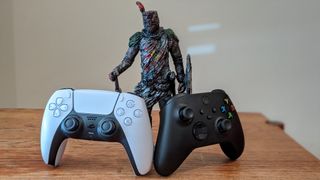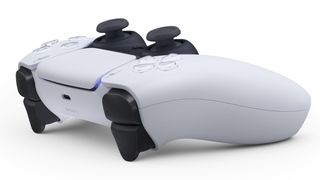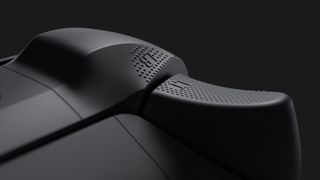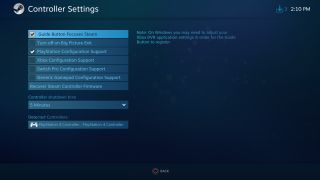Xbox controller vs. PlayStation DualSense: Old reliable or new hotness?
Which one is the better controller for PC gamers?

If you already have a powerful gaming PC, buying a new PlayStation 5 or Xbox Series X might not make much sense. They're pricey, and many of their games are already available on PC. But buying a new controller to play some of those games on PC is a different story. A new controller can give you a taste of that next-gen excitement for a lot less money.
For the last week I've been playing games with the new Xbox Series X/S controller as well as the PlayStation DualSense, which has been grabbing attention thanks to its new haptic motors. They're both great—here's the rundown of how they compare, what they each do especially well, and how easy they are to use with a PC today.
New Xbox controller and DualSense: The basics
| Features | Xbox controller | DualSense |
|---|---|---|
| Haptics | Yes, and "Impulse" triggers | More powerful and nuanced motors, and "Adaptive" triggers |
| Motion sensor | No | Gyroscope + accelerometer |
| Microphone | No | Yes |
| Speaker | No | Yes |
| Headphone jack | 3.5mm (and "expansion" port) | 3.5mm |
| Battery | 2x AA | 1,560 mAh rechargeable |
| USB | USB-C | USB-C |
| New buttons | Share, reworked D-Pad | Mic mute |
| Wireless tech | Xbox Wireless Radio (console), Bluetooth Low Energy | Bluetooth 5.1 |
| Weight | 292.5 grams | 282.5 grams |
| Price | $60/£55 | $70/£59 |
Xbox controller's notable design changes: The new Xbox controller's shape is only slightly changed from the Xbox One design, which Microsoft says is meant to better fit smaller hands (it still fits my larger hands very well). The D-Pad is completely redesigned with a very clicky raised circular design that seems to make both cardinal and diagonal inputs precise and easy. The back of the controller has a new, rough texture to provide better grip, and it feels great. The bumpers and triggers are now matte instead of glossy plastic, and the triggers have that same grippy texture on top, too.
The tension of the joysticks, buttons and triggers is unchanged, but the triggers and bumpers feel nicer to press thanks to the matte finish. There's now a share button in the center of the controller for quickly taking screenshots or video on the Xbox. The tyranny of micro-USB is one step closer to death as the Xbox controller switches to USB-C.
PlayStation DualSense's notable design changes: The DualSense retains the same joysticks and button placements of the DualShock 4, but with a more rounded grip shape this time. The large lightbar is gone, replaced by a more subtle glow around the touchpad. The Options and Share buttons are slightly smaller and much clickier. A small microphone mute button has been added under the PS logo button.
The real changes are mostly internal. The triggers are slightly larger, and can now "push back" against your finger with a gear that changes the tension. The traditional weights that create haptic feedback have been replaced by larger, more powerful motors that can create much more nuanced rumble. USB-C kicks micro-USB to the curb.
The face-off: Xbox vs. DualSense

Controller marketing has made a big deal out of rumble before, but nothing has delivered like the DualSense. Play a PS5 game that takes advantage of how powerful its haptics can be, like pack-in Astro's Playroom, and you'll immediately feel the difference. There's never been a controller that could deliver specific sensations to your hand like this before. The triggers are the less flashy new feature, but probably even more useful—being able to add tension to a trigger pull or an accelerator or any action, even climbing up a ledge, is really exciting.
The biggest gaming news, reviews and hardware deals
Keep up to date with the most important stories and the best deals, as picked by the PC Gamer team.
I wrote in more depth about how cool the DualSense's new tech is here, so I won't belabor the point. But the hype is justified.
Switching to the Xbox controller after using the DualSense and feeling the haptics in a game like Forza Horizon 4, it really does feel suddenly very old-fashioned. It's a bit like switching from SD to HD. There's so much clarity and detail in that new rumble. Even taking those advanced features away, I think the DualSense is a subtle improvement over the DualShock 4. It's a bit wider and more contoured, which fits better into my hands. That might not be the case for someone with smaller hands than mine. It also got rid of the hard rims around the D-Pad and face buttons for a smooth surface, which just makes it overall more pleasant to hold.
But even with those improvements, there's something about the Xbox controller's shape that just feels perfect. I thought it was perfect with the Xbox 360, and then Microsoft made it better. I thought it was perfect with the Xbox One, but again, it's better, though more subtly this time. The slightly shorter, smaller grips accommodate more hand sizes without sacrificing comfort for big hands like mine. It has a bit more of a pyramid profile than the DualSense—my hands feel really far apart on the DualSense when I press the shoulder buttons, while the Xbox brings my fingers closer together. You hold the DualSense, but you cradle the Xbox controller.
It feels both cozier and more alert, almost like taking a boxer's stance. And a couple more pros on the Xbox side: the new rough texture on the back and the triggers, and the overall matte finish feels fantastic and super grippy. It feels really high quality, the kind of very precise, thoughtful iteration you get when you're trying to improve on an already-very-good design.

Microsoft has simply mastered the fundamentals, and there are three other aspects of its design I prefer over the DualSense:
- The asymmetrical analog stick placement, giving the left stick priority. Totally my preference here, but I've always liked this layout better.
- The rubber texture of the analog stick on the Xbox controller gives you a much more concave "cup" to rest your thumb in, or a grippy rim to push against. I find the Xbox analog sticks more precise and comfortable under my thumb. The DualSense uses the same stick rubber as the DS4, which I believe Sony improved over time (launch DS4 sticks got torn up notoriously easy), but they still feel less durable than the Xbox's.
- The Xbox's new 8-way D-Pad has a very loud, satisfying click to it as you register inputs. It's a real pleasure just to wiggle your thumb around on it. I'll wait for the fighting game pros to weigh in on how perfectly it registers inputs, but I think it might be the best D-Pad on any modern controller.
If I had to pick one of these controllers, it would honestly be a struggle. Generally, I'd rather hold the Xbox controller, feel that textured back on my palms and use its analog sticks and D-Pad. But it's kind of comparing very, very good to simply very good. The DualSense has a nicer shape than the DualShock 4 even before you consider its impressive new features.
I wish I could have the DualSense's new haptics and adaptive triggers in the Xbox pad, because they really do win the day. If I know a game I'm excited for makes use of those features—including the speaker in the DualSense, which helps add meaning to what your brain thinks you're feeling when the haptics fire—I'd absolutely choose it over the Xbox pad. They're that cool.
But that brings us to a big hanging question: Will the DualSense work on PC?
DualSense and Xbox on PC

If you plug the Xbox controller into your PC with a USB cable, it works like any past Xbox controller—it's quickly recognized by Windows and just works. (One caveat is that the Share button doesn't seem to automatically map to anything, but I wouldn't be surprised to see that change post-launch.
Oddly, while the Xbox controller does support Bluetooth connectivity, putting it in pairing mode didn't show up for my Bluetooth adapter. I had no issue connecting to the DualSense with Bluetooth.
The DualSense also works fine in Windows if you plug it in or connect via Bluetooth, but "working" is a lot more limited here. Because it registers as a generic DirectInput controller, it won't work in many games that are built to support the Xbox pad. Steam's controller configurator helps—with it you can map all the buttons and tell Steam to treat it like a DualShock 4, meaning you'll even get PlayStation button prompts in the Steam UI and in games that support it.
Unfortunately, the drawback right now is that the new haptic motors don't work with this setup. Steam may quickly add better support for the DualSense and bring the rumble online. But even then, actually getting the real benefit of the DualSense's more advanced rumble and its adaptive triggers requires specific game-by-game programming.
I'm eager to see what the mod community does to support the DualSense; maybe we see a tool like DS4Windows pop up in the first few months. But without an official driver, it's unlikely that any games will be able to support the full functionality of the DualSense on PC.
For now, the Xbox controller is the better PC experience. It's easy. Microsoft has honed its shape to perfection (at least until next time). But it does feel like the last iteration of an old style of controller, while the DualSense is the first of a new breed that enhances the experience of playing a game. Let's hope PC gamers get a piece of that action.

Wes has been covering games and hardware for more than 10 years, first at tech sites like The Wirecutter and Tested before joining the PC Gamer team in 2014. Wes plays a little bit of everything, but he'll always jump at the chance to cover emulation and Japanese games.
When he's not obsessively optimizing and re-optimizing a tangle of conveyor belts in Satisfactory (it's really becoming a problem), he's probably playing a 20-year-old Final Fantasy or some opaque ASCII roguelike. With a focus on writing and editing features, he seeks out personal stories and in-depth histories from the corners of PC gaming and its niche communities. 50% pizza by volume (deep dish, to be specific).

Genshin Impact's missing English voice acting returns in its latest trailer, but players aren't sure if they should celebrate yet

Palworld developer reports Nintendo's suing over 3 Pokémon patents for only $66,000 in damages, but a videogame IP lawyer says fighting the lawsuit could mean 'burning millions of dollars'

The best Black Ops 6 map for XP grinding finally got a 24/7 playlist, so you know what to do
Most Popular

